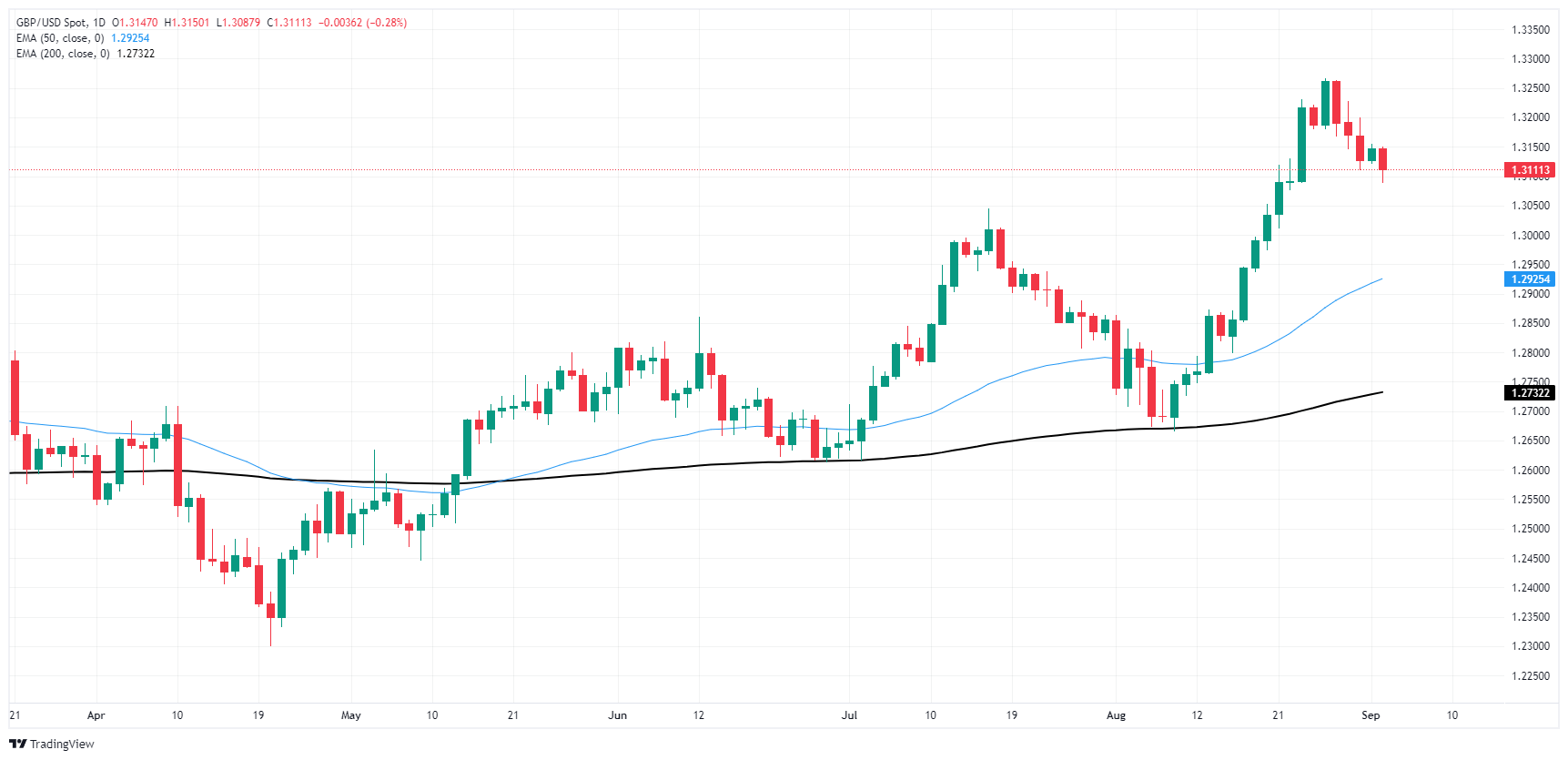- Analytics
- News and Tools
- Market News
- GBP/USD tests low end amid Greenback recovery
GBP/USD tests low end amid Greenback recovery
- GBP/USD erased further below 1.3150 on Tuesday as markets bid the Greenback.
- Market sentiment took a hit after US PMI figures failed to meet expectations.
- US NFP figures loom ahead as traders try to gauge the depth of a first Fed rate cut.
GBP/USD softened on Tuesday, briefly testing below 1.3100 as Cable struggles to hold onto a bullish stance amid a near-term bearish pullback. Greenback bidding picked up the pace after a fresh batch of US Purchasing Managers Index (PMI) figures failed to meet market expectations, reigniting investor concerns about the potential for a US recession.
Forex Today: The prospects of a US soft landing remain challenged by data
The data docket remains thin on Wednesday from the UK side, with little of note outside of low-tier final PMI figures for August. US labor figures remain a key point for market participants this week.
ISM’s US Manufacturing PMI for August came in below expectations, printing at 47.2 and missing the median market forecast of 47.5. Despite a soft rebound from July’s multi-month low of 46.8 failed to galvanize markets, giving already flighty investors a perfect excuse to pull back from a recent lopsided tilt into bullish expectations.
Friday's US Nonfarm Payrolls (NFP) report looms large. It represents the last round of key US labor data before the Federal Reserve (Fed) delivers its latest rate call on September 18. Friday's NFP print is widely expected to set the tone for market expectations regarding the depth of a Fed rate cut, with investors fully priced in on the start of a new rate-cutting cycle this month.
GBP/USD price forecast
Cable has backslid from multi-month highs above 1.3250 back below the 1.3150 level as Greenback selling pressure cools, but the pair is stubbornly sticking to recent highs after vaulting to a peak 29-month bid in August. Price action is still tilted firmly into the bullish side above the 200-day Exponential Moving Average (EMA) at 1.2725, while the immediate downside technical target for shorts will be the 50-day EMA just above the 1.2900 handle.
GBP/USD daily chart
Pound Sterling FAQs
The Pound Sterling (GBP) is the oldest currency in the world (886 AD) and the official currency of the United Kingdom. It is the fourth most traded unit for foreign exchange (FX) in the world, accounting for 12% of all transactions, averaging $630 billion a day, according to 2022 data. Its key trading pairs are GBP/USD, aka ‘Cable’, which accounts for 11% of FX, GBP/JPY, or the ‘Dragon’ as it is known by traders (3%), and EUR/GBP (2%). The Pound Sterling is issued by the Bank of England (BoE).
The single most important factor influencing the value of the Pound Sterling is monetary policy decided by the Bank of England. The BoE bases its decisions on whether it has achieved its primary goal of “price stability” – a steady inflation rate of around 2%. Its primary tool for achieving this is the adjustment of interest rates. When inflation is too high, the BoE will try to rein it in by raising interest rates, making it more expensive for people and businesses to access credit. This is generally positive for GBP, as higher interest rates make the UK a more attractive place for global investors to park their money. When inflation falls too low it is a sign economic growth is slowing. In this scenario, the BoE will consider lowering interest rates to cheapen credit so businesses will borrow more to invest in growth-generating projects.
Data releases gauge the health of the economy and can impact the value of the Pound Sterling. Indicators such as GDP, Manufacturing and Services PMIs, and employment can all influence the direction of the GBP. A strong economy is good for Sterling. Not only does it attract more foreign investment but it may encourage the BoE to put up interest rates, which will directly strengthen GBP. Otherwise, if economic data is weak, the Pound Sterling is likely to fall.
Another significant data release for the Pound Sterling is the Trade Balance. This indicator measures the difference between what a country earns from its exports and what it spends on imports over a given period. If a country produces highly sought-after exports, its currency will benefit purely from the extra demand created from foreign buyers seeking to purchase these goods. Therefore, a positive net Trade Balance strengthens a currency and vice versa for a negative balance.
© 2000-2024. All rights reserved.
This site is managed by Teletrade D.J. LLC 2351 LLC 2022 (Euro House, Richmond Hill Road, Kingstown, VC0100, St. Vincent and the Grenadines).
The information on this website is for informational purposes only and does not constitute any investment advice.
The company does not serve or provide services to customers who are residents of the US, Canada, Iran, The Democratic People's Republic of Korea, Yemen and FATF blacklisted countries.
Making transactions on financial markets with marginal financial instruments opens up wide possibilities and allows investors who are willing to take risks to earn high profits, carrying a potentially high risk of losses at the same time. Therefore you should responsibly approach the issue of choosing the appropriate investment strategy, taking the available resources into account, before starting trading.
Use of the information: full or partial use of materials from this website must always be referenced to TeleTrade as the source of information. Use of the materials on the Internet must be accompanied by a hyperlink to teletrade.org. Automatic import of materials and information from this website is prohibited.
Please contact our PR department if you have any questions or need assistance at pr@teletrade.global.















